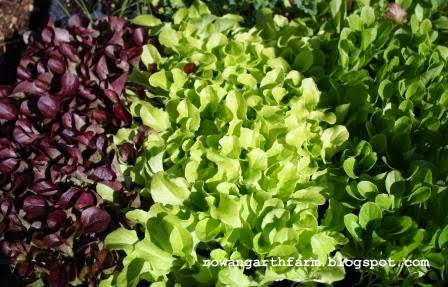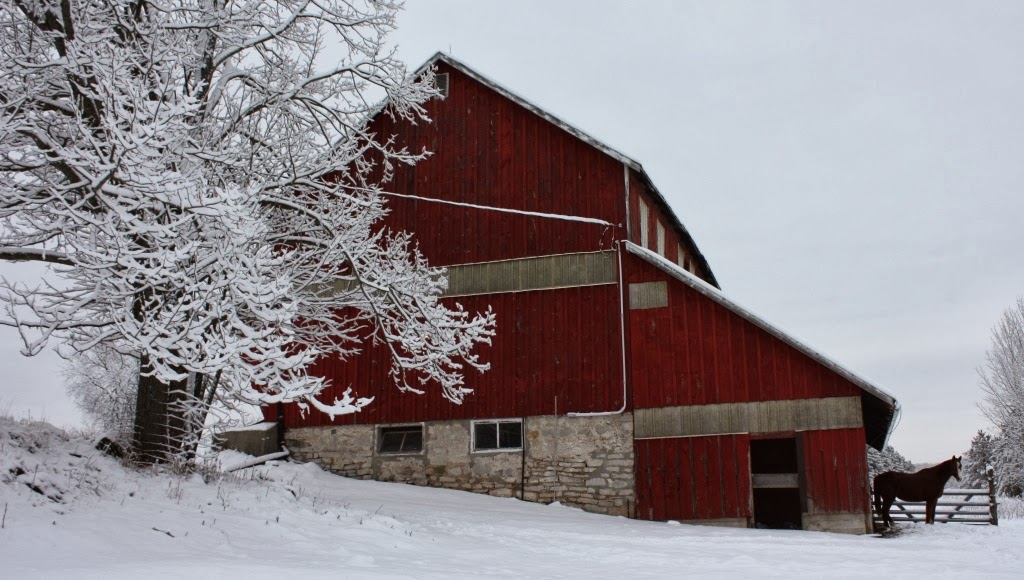
So, first off, I have to apologize for posting once and then disappearing. It's been a busy week. The kids and I were in Georgetown last weekend visiting friends and celebrating their four-year-old son's birthday.
In fact my kids did more visiting than me as I spent Saturday at
Everdale, this amazing organic farm and environmental learning centre outside of Erin, Ontario. I was at a workshop sponsored by the
Ecological Farmers Association of Ontario on Pastured Poultry. Yep, I schleped all the way to Georgetown to learn about... chickens. And I'm so glad I did.
Pastured poultry is not to be confused with free range chickens, who run willy-nilly throughout the barnyard. It's actually a management system that calls for the raising of birds, either layers or broilers (meat birds), on, you guessed it -- pasture. There are different kinds of pasture systems, such as closed pens on wheels that are moved daily or stationary housing that is penned off with electrical fencing. But regardless of the actual design, birds experience a much lower-stress existence than they would in confinement and have access to fresh, green grass, which makes up between 5% and 15% of their feed requirements.
Now I'm quite partial to the willy-nilly free range system, but there are risks. For example, particularly stealthy birds may start laying outside the henhouse (making eggs downright impossible to find) while chickens allowed to run free can be choice pickings for predators such as owls, weasels or even dogs.
Everdale has a neat system that seems to meet in the middle. The farm's henhouse, encircled by three strands of electrical fencing, is parked in one spot from April until the weather turns really cold. Beside the chicken coop is a mostly-permanent hoop-house shelter for the farm's 20 sheep. The chickens are allowed to leave the henhouse area (and the more adveturous ones certainly do!) but the sheep can't get past the electrical tape and get into the chicken feed.
Around these two structures, there's an electrical netting fence that cordens off about an acre of pasture. That fencing gets moved around, giving the foraging animals (sheep, donkeys and one marauding cow) access to fresh greens, which includes pasture and some of the season's spent vegetable garden (Everdale is also a CSA (Community Supported Agriculture), which provides approximately 200 local families with fresh produce each week in exchange for purchasing an annual "share" in the farm).
It's a harmonious and productive existence in which the chickens scratch at the sheep and donkey poop (cutting down on the parasite load), while getting loads of fresh air and good greens. This was my introduction to biodynamic farming, and I'm looking forward to learning more about it at the
Great Lakes CSA Conference in November.
So, what does this have to do with us? Well, Everdale is such an inspiring place that I began revisiting my plans for our farm animals. So far my list includes: chickens for eggs (for our consumption and eventually farm-gate sale), a few goats for milk (and weed control!), some sheep for wool (Henry has been so patient waiting for a sheep and I'm looking to bone-up on my knitting skills) and a donkey, to keep an eye on everyone (donkeys offer excellent predator protection.) I'd also love to get a horse (or two?) but for now, I'm taking lessons and enjoying my coach's lovely mounts.
The plan was to get some day-old chicks in the spring (it's too late in the year to get babies from the hatchery that supplies our local co-op.) I did manage to get a price listing from the 2008 season, so I was able to research the breeds I was interested in: Rhode Island Reds and Plymouth Rocks. While not as prolific at laying eggs as the ever-popular Leghorn, these breeds are less flighty and nervous and more social and hardier. Perfect!
That was the plan, at least. Then this morning, I got my daily
Kijiji postings on Livestock for Sale in the Peterborough and Belleville areas (this could be a very dangerous mailing list for me -- I've already been looking into Saanen goats, Australian Shep pups and a four-year-old thoroughbred!). There was a lady offering 15 laying hens for sale for $5 each. Hmmmm..... eggs AND experience now?
I emailed the woman and she's got a mix of one- and two-year-old laying Rhode Island Reds, Black Rocks and Plymouth Rocks. Coincidence? I think not.
Now, many commercial poultry farmers (and even many small flock farmers) won't keep birds after two years because their production starts to decrease (though chickens can live for 10 to 15 years!) Eventually, you get the point where the feed costs more than the bird produces. But these birds aren't at that stage yet and even with less light and the colder weather (which also puts a downward pressure on production) I thought it'd be worthwhile to purchase a few hens.
We already have an area set up in the barn (which is now cleared of years of other people's junk, but that's a whole other rant, I mean posting) so the biggest investment was in a feeder, water fountain, heat lamp, feed (25 kg costs $14, and each hen eats two pounds per week, if anyone's wondering) and wood shavings. That came to about $75 (the heat light bulb itself was $10!)
We'd need those things for the springtime anyway so it was just a question of whether I wanted to take the "risk" and try out some older birds -- and schlep out the barn twice a day in minus 30 degree winter weather! We'll also have to shell out more in hydro (we're not on solar.. yet!) because of the heat lamp and extra lighting (layers need 14 hours of light daily) though additional livestock in the barn could increase the temperature inside!
"Hell, yes!" I said, feeling like this would take me one step closer to my dream of being a modern-day homesteader. Plus, I thought it'd be a great experience for the kids. But to be sure, I asked the
forum folks at
BackyardChickens.com, an amazing place about all things chicken, if it was a good way for a newbie to get started.
I got back some great responses that pretty much echoed my thoughts -- good for experience, maybe less production but it's a viable way to get eggs now and have a steady supply until the babies start producing next summer (it takes about 20 weeks for a layer to start, well...laying.)
So, I contacted this lady and asked if she'd be interested in selling 10 hens. Sounds like a lot, I know. But apparently the magic formula for calculating egg production per day is taking the number of eggs you want each day, dividing that number by 2 and multiplying by three. So, nine hens would produce six eggs per day -- sometimes more, sometimes less.
To cut a ridiculously long story to a more manageable level, she said "sure!" So as of Sunday, we will be the proud owners of a mixed bunch of egg laying hens.
I say 'we' quite intentionally, as this chicken business is turning into something of a family affair. The kids are looking forward to collecting eggs (I'm sure my four-year-old daughter will think of them as her personal petting zoo!) and my devoted, and exceptionally tolerant, husband is outside right now making nesting boxes and hopefully a roost for the new arrivals.
While they may be starting out their life at Rowangarth Farm in our barn, they'll be running willy-nilly throughout our barnyard in no time.
 After my last, well... "wordy" posting, this one is going to be all about the photos.
After my last, well... "wordy" posting, this one is going to be all about the photos.













